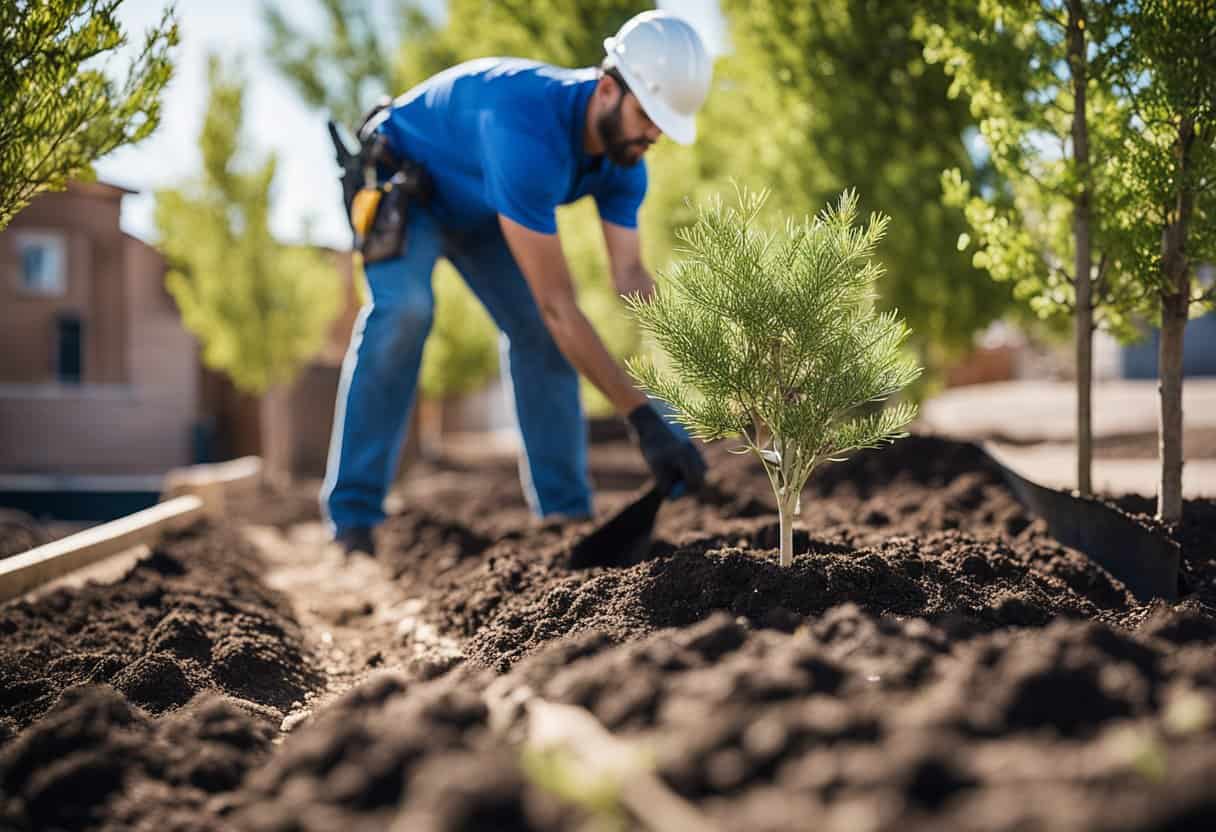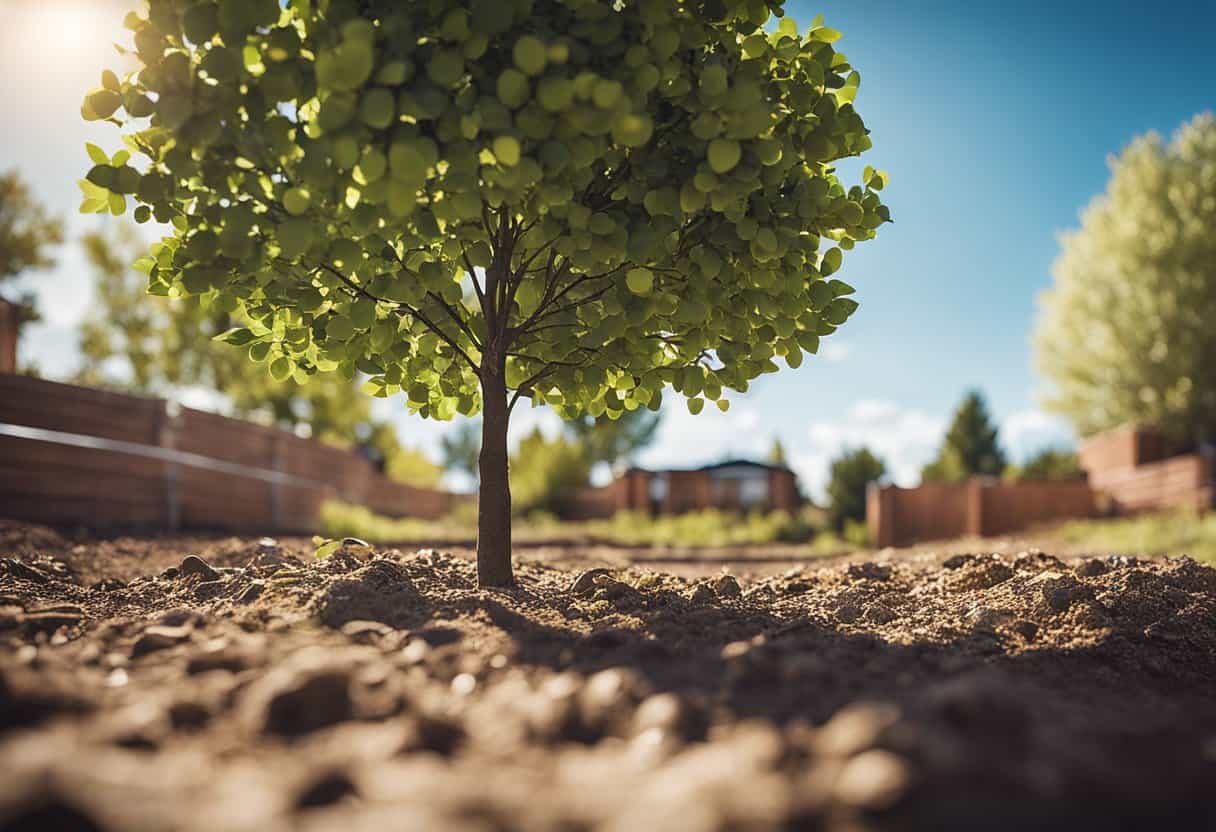Importance of Using a Contractor for Tree Planting

Planting trees in Pueblo, Colorado, requires skill and expertise. Homeowners can benefit from using a professional contractor to ensure optimal tree health and growth. One advantage of hiring a contractor is that many landscaping and tree contractors have certified arborists on staff. Arborists possess advanced knowledge in tree care.
Safety is a priority when planting trees. Contractors have the correct equipment and training to avoid accidents or property damage. A professional team can assess potential hazards, ensuring the safety of your property and family.
In addition, a tree planting contractor brings essential equipment for the job. This includes tools for digging, lifting, and transporting heavy trees. The right equipment saves time and labor, providing a hassle-free experience for homeowners.
Soil Considerations for Planting Trees
John and Chip (well mostly Chip) Discuss the Process of Planting Trees in Clay Soil – Like What we Have Here in Pueblo
When planting trees in Pueblo, Colorado, it is crucial to consider soil type and tree health. Soil erosion can also impact the success of tree planting. Taking time to understand and prepare the soil properly can lead to healthier, more resilient trees.
Of primary importance is the soil’s texture and composition, as these impact both water drainage and nutrient availability. In general, sandy soils allow for better drainage but may lack essential nutrients for tree health.
On the other hand, clay soils contain more nutrients but can lead to poor drainage. Before planting, analyzing your soil type and amending it if necessary will help ensure strong, thriving trees.
Preventing soil erosion is another important factor when planting trees in residential areas. Soil erosion can compromise tree health and stability, as it removes nutrient-rich topsoil and exposes tree roots.
Implementing practices such as using mulch around newly planted trees, planting trees with hearty root systems, and creating barriers to reduce runoff can help protect the soil and newly planted trees.
While selecting tree species to plant, consider native trees adapted to the local climate and conditions. Native trees, such as the Texas Red Oak – which is on the City of Pueblo’s Recommended Trees List, offer better drought resistance and pest tolerance, increasing the chances of successful growth and development in Pueblo’s environment.
Water Considerations for Tree Planting
Watering Newly Planted Trees
Proper watering plays a key role in maintaining tree health and promoting growth. It is crucial to keep trees hydrated, especially during the initial stages of planting.
Newly planted trees require regular deep watering, which can be done with a slow-running hose, a bubbler-type irrigation head, or a tree watering bag. These methods help ensure that the soil surrounding the tree remains moist and enables effective root establishment. Adequate tree care in the first year is vital, as it helps the tree adapt to its new environment and reduces the risk of stress-related issues.
It is essential to avoid overwatering, as it can lead to root rot and other health problems. The frequency of watering depends on the tree species, soil type, and climate. In general:
- For the first two months, water the tree deeply every week to maintain the soil’s moisture.
- After the initial period, reduce the watering frequency to once or twice per month.
Monitoring soil moisture helps determine when to water. A simple technique is to probe the soil with a finger or screwdriver. If the soil is dry at a 2-4 inch depth, it is time to water. Avoid watering when the soil feels wet, as it can lead to oversaturation.
Choosing the Right Trees and Shrubs for Your Pueblo Property

When planning to plant trees or shrubs in your Pueblo, Colorado property, consider using native species. These trees are well-suited to the local climate, soil, and environment. They require less maintenance compared to non-native species, making them an ideal choice for residential landscapes.
To ensure success in tree planting, it’s essential to select the right tree or shrub for the specific area. Climate, soil type, and available space should be carefully considered. Native trees in Pueblo are available in various sizes and types, ranging from fast-growing shade trees to fruit-bearing or ornamental species.
Before planting, make sure to research the specific needs and characteristics of each species, including sun exposure, drainage requirements, and potential size at maturity. This information will help to decide which species are best suited for your property and ensure their long-term health and growth.
Space Considerations for Tree Planting
Envision the Mature Tree Prior to Planting
When planning your landscape, think of how the tree will look when fully grown. Consider the tree’s height, width, and root growth. This will help avoid future issues with tree trimming or pruning. It’s essential to choose the right tree species for the available space to minimize future maintenance.
Distance From Other Greenery
To grow well, trees need enough space to spread their roots. Planting trees too close will make them compete for water, nutrients, and sunlight. As a rough guide, plant trees at least as far apart as their expected mature canopy width. If you’re planting several trees, arrange them in a way that allows for easy access for care such as landscaping and pruning.
Distance From Roofs and Other Structures
Another crucial factor to consider is the location of your tree relative to your home, fences, and other structures. Trees should be planted far enough away to prevent damage from roots or branches. This will also facilitate tree maintenance, including trimming and pruning, ensuring the tree grows healthy without posing a risk to the structures.
Remember to plan for the tree’s full size and pay close attention to underground utilities, such as water, gas, and sewer lines. Ensuring that there is sufficient room for trees to grow will prevent future issues and contribute to a well-maintained landscape.
Types of Trees Ideal for the Pueblo Climate
The climate in Pueblo, Colorado, is classified as USDA Hardiness Zone 5, which experiences winter temperatures between -10 and -20 degrees Fahrenheit. This allows for a variety of cold-hardy trees to thrive in the area. Native species are the best choices for local landscaping, as they have adapted to the unique conditions.
One popular native tree is the Gambel’s Oak (Quercus gambelii), a deciduous tree that grows around 25-30 feet in height. It is abundant in the state and can be found in dense groves with ease. Some other suitable tree varieties for Pueblo residents include the Scotch Pine (Pinus sylvestris), Douglas Fir (Pseudotsuga menziesii), Bur Oak, Crabapple, and certain Elm hybrids.
Diversifying the tree selection on your property is a sound strategy – with no single species representing more than around a quarter of the total tree population on your property. Doing so helps reduce the susceptibility to insects, diseases, and weather-related damages, ensuring a healthier and more resilient urban forest.
How Your Pueblo Contractor Plants Trees: The Process
When you hire a tree planting service in Pueblo, Colorado, you may work with certified arborists who follow a specific process to ensure the healthy growth of your trees. This section outlines the general steps a contractor takes to plant trees.
Contractor Digs a Hole 2-3 Times Larger Than the Root Ball
The first step in planting a tree is digging a hole. Expert contractors in Pueblo understand that the hole must be 2-3 times larger than the tree’s root ball. This provides ample room for the roots to grow and establish themselves in the soil. The hole is usually as deep as the root ball itself, ensuring the tree will be planted at the proper depth.
Contractor Positions Tree in the Hole
Next, the contractor will carefully place the tree into the hole. It’s essential to position the tree correctly to avoid damaging the roots or trunk. In some cases, a certified arborist in Pueblo may use specific equipment to lift the tree without causing harm.
Dirt is Then Backfilled Into Hole With Minimal Compaction
Once the tree is in place, the contractor begins to fill the hole with soil. This process, called backfilling, requires a gentle touch. Contractors carefully add soil around the root ball without packing it too tightly to allow for adequate air and water to reach the roots.
Time to Fertilize, Water and Mulch
After the tree is in the ground, the contractor will apply water, and mulch and perhaps fertilizer depending on the requirements for your tree. Fertilizer provides essential nutrients for the tree’s growth, while water helps the roots establish themselves in the soil. Mulch helps retain moisture, suppress weeds, and regulate soil temperature around the tree.
Frequently Asked Questions
What Trees are Native to Pueblo, Colorado?
Pueblo, Colorado is home to various native tree species, ideal for residential landscaping. When choosing local options, your plants will thrive better in the climate and soil. A great resource is “Loving Our Native Plants” resource put out by the Pueblo County CSU extension which details appropriate plants and trees at the bottom of the page.
When is the Optimal Time to Plant Trees in Pueblo?
The best time to plant trees in Pueblo would be during the early spring or fall. Planting during these seasons allows tree roots to establish before extreme weather, such as summer heat or winter cold, sets in. Be mindful of specific tree species’ needs and adapt your planting schedule accordingly.
How Much Does it Cost to Buy a Tree and Get it Planted in Yard in Pueblo?
The cost of planting a tree can vary from as low as around $100 and can go up to $2000 or more. Cost depends on factors such as tree size, quantity, and access to the site. Smaller trees can be more affordable, while prices for larger specimens will typically be higher. Keep in mind that costs may also include delivery, installation, and additional materials such as mulch or fertilizer.
Tree Planting
Add Privacy, Shade, and Protect Your Grass with New Trees

DIY Yard Care
Check out our blog for information on how to do upkeep around your yard. Tips and tricks for keeping your lawn, plants and trees healthy.

Pueblo Events Calendar
A monthly listing of the events for you and your family to enjoy in and around Pueblo

Tree Planting Blog Posts
Below are blog posts from our blog related to tree planting and overall tree health.
Pueblo Colorado Arbor Day Celebration 2024
COMPLETE LIST OF ALL SERVICES
All Services
Click a Link Below for More Information About Services Provided
Hardscaping
Curbing
Decks
Fence Maintenance & Install
Fire Pits
Landscape Lighting
Outdoor Kitchens
Patios
Pergolas & Gazebos
Retaining Walls
Walkways
Sprinkler Systems
General
Fall Cleanup-Leaf Removal
Landscape Design
Mulching
Organic Landscaping
Snow Removal
Spring Cleanup
Water Features
Xeriscaping
Trees, Shrubs & Perennials
Flower Beds & Planters
Hedge & Shrub Trimming
Stump Grinding
Tree Planting
Tree Removal
Tree Trimming & Pruning
Lawn Maintenance
Lawn Aeration
Lawn Dethatching
Lawn Edging
Lawn Fertilization
Lawn Mowing
Pest Control
Weed Control
Drainage Issues
Sod & Turf
OUR SERVICE AREA
Serving Pueblo and Surrounding Suburbs
The perfect Pueblo landscaper for your needs.
For more information, click on your community below
LET’S GET STARTED
Contact Us
Pueblo Landscaping Lynx
Phone:
719.867.0821
Email:
operations@pueblolandscapinglynx.com
Hours:
Sun – Sat: 8am – 6pm
